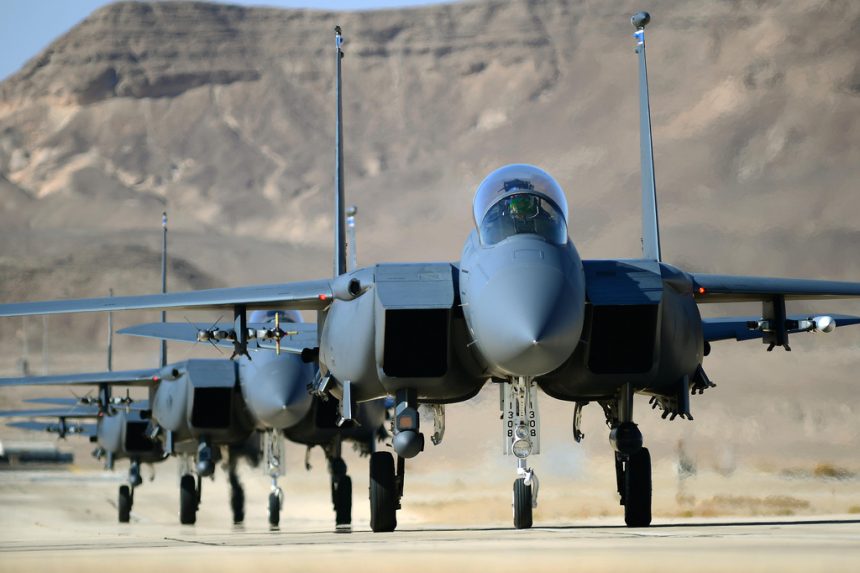It won’t be easy to strike all ISIS positions in Syria and Iraq. But the U.S. has already amassed several “useful” weapons systems in the region.
Last year, when the U.S. (and France) seemed to be about to launch air strikes on Syria and its chemical weapons, we explained that the air campaign would probably be a limited air war, opened by the usual rain of cruise missiles shot by warships, submarines and bombers with little to no involvement of the so-called “tacair”, the tactical airplanes.
13 months later, the scenario has changed a bit.
Several F-15E Strike Eagles and F/A-18E/F Super Hornets carrying their PGMs (Precision Guided Munitions), are already flying over Iraq hitting ISIS targets five times a day, and they prepare to expand their mission to attack terrorist targets located in Syria.
Whilst last year there was no sign of imminent deployment of F-15s, F-16s or F-18s squadrons to airfields across the region, several warplanes, along with support assets (including tankers and ISR – Intelligence Surveillance and Reconnaissance – platforms) are not only in place, but they are also flying daily missions over Iraq since July.
And, above all, there’s a supercarrier and its powerful Strike Group sailing in the Persian Gulf and pounding militants.
Stand-off weapons, cruise missiles and….stealth bombers?
Since U.S. planes are already freely flying inside Iraqi airspace, it is quite likely they will continue to do so to perform surgical attacks on ISIS targets in Iraq. The aircraft are deployed to Al Udeid, Qatar, and Al Dhafra, UAE, but they could also count of Jordan airbases, some of which already host some U.S. Marine Corps F/A-18 Hornets and Air Force F-16s.
On the other side, Syrian targets will be more difficult to hit: unless Washington will be allowed to use Syria’s airspace any incursion could theoretically require plenty of Electronic Warfare cover and SEAD (Suppression of Enemy Air Defense) support to make Syrian Air Defense harmless. In other words, the unathorized use of Damascus airspace would not be cost-effective along with causing diplomatic issues, as it would require the U.S. to fight a war against Syria (by blinding or destroying Syrian radars and SAM – Surface to Air Missile – batteries) and against ISIS in Syria. And don’t forget that some Syrian Arab Air Air Force planes are fighting their war against local rebels and this raises two issues: deconfliction with SyAAF planes and the risk of being shot down by MANPADS (Man Portable Air Defense Systems) or other Anti-Aircraft weaponry in the hands of the Free Syrian Army.
A more clandestine approach is probably ahead, with a war made of drone strikes, stand-off weapons, and some limited stealth air strikes.
Dealing with drones, as said, they are already operating in Iraq, hence, they could extend their current mission to perform Strike Coordination And Reconnaissance missions in or close to Syria from Incirlik, in Turkey, that has been used as a drone forward operating base, for several years.
Cruise missiles could be fired U.S. destroyers theoretically capable to launch up to 90 Tomahawks Tactical Cruise Missiles as the USS Cole, currently in the Sixth fleet area of operations.
Some more cruise missiles could be fired by U.S. strategic bombers that would perform some global reach, round trip missions from the US (as well as from Diego Garcia): for sure, B-2 Spirit stealth bombers‘ r/t sorties from Whiteman Air Force Base, Missouri, to be followed by some more B-1 air strikes as done during the Libya Air War in 2011, and possibly B-52 ones.
Wars are always an opportunity to test new weapons systems so we can’t rule out an extended campaign in Iraq and Syria will eventually see the baptism of fire of the F-22 Raptor as a multi-role jet or even the mysterious triangle-shaped bomber spotted over the U.S. few months ago. Six F-22s are already stationed at Al Dhafra, in the Gulf area.
High flying U-2 Dragon Lady aircraft and Global Hawk drones flying from Incirlik, Sigonella or Al Dhafra are already getting the required imagery and will perform the post-strike BDA (Battle Damage Assessment) should the need arise.
Even if it will be an American air war, allied air arms will take part in the strike. France was about to fire some Scalp missiles from a handful of Rafale jets in 2013; they will probably ready their “omnirole” fighter jets this time. The UK has already committed some Tornado GR4s to perform reconnaissace and air-to-surface missions, whereas the Italian MoD has affirmed Rome is ready to offer its tanker aircraft (most probably the advanced KC-767 aerial refuelers).
Image credit: U.S. Air Force















